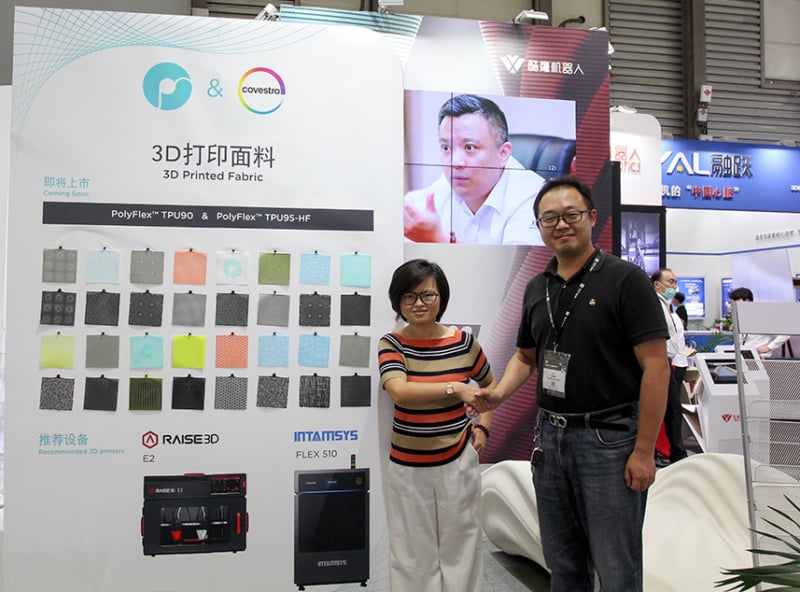Covestro and Polymaker have been in partnership for years to promote high-performance 3D printing materials and to develop new 3D printing applications.
Covestro focuses on the manufacture of high-tech polymer materials. Serves segments such as the automotive, construction, wood processing and furniture, electrical and electronics industries, sports and leisure, cosmetics, health and the chemical industry.
Polymaker is a high-tech company specializing in 3D printing materials for various industries. Its products are widely used in automotive, aerospace, industrial manufacturing, medical, consumer and other fields by customers around the world.
By using 3D printing to create a 2D fabric, together they have a new approach to fabric production. A new processing technology with the industry’s top 3D printer manufacturers Intamsys Flex 510 printer and Raise3D E2 printer to improve mass production and efficiency. They are highly adapted for printing flexible materials which match the characteristics required for 3D printed fabric.

Existing Materials Used For 3d Printing
Usually Acrylonitrile Butadiene Styrene (ABS) and Polylactic acid (PLA) are considered as standard plastics for printer filament but due to insufficient flexibility, they can’t be used in bending prototypes. On the other hand, TPU printing filament is flexible in nature. It can bend easily without any effect on the design, strength and durability. It is widely used in daily necessities, sports goods, toys, decorative materials and other fields in traditional manufacture.
COVESTRO X POLYMAKER TPU For Printing Textiles
In the selection of materials for the development of 3D printing fabrics, Polymaker cooperated with Covestro to select from the many varieties of TPU (Thermoplastic polyurethanes) for 3D printing development. It is a thermoplastic polyurethane elastomer, which has a wide range of hardness, wear resistance, oil resistance, transparency, thermal stability and good rubber-like elasticity. It is also resistant to oils, greases, and a variety of solvents. Being firmer than TPE, TPU is therefore also much easier to 3D print with.
Recommended extrusion temperature range is between 225-250°C depending on the type of a 3D printer and TPU filament. Printing with higher temperatures will allow the filament to melt faster and to flow easier from a nozzle.
TPU 3D filament diameters are typically either 1.75mm or 3mm. Although some type of TPUs are water-resistant, prolonged contact with water could result in degradation of the product.
Covestro TPU materials are rich in variety and performance. The 3D printing fabrics released recently include 90A and 95A, two hardness materials.
ADVANTAGES Of Using Covestro X Polymaker 3d Printing
- The 3D printing technology has been widely integrated into manufacturing, sport and leisure, medical and other fields. Now its offering new applications to the textile industry with flexible production process of both mass production and customisation.
eg. Production of a 3D printed shoe uppers can be printed in 30 minutes. A single 3D printer could produce 48 uppers 24 hours a day. Due to the characteristics of 3D printing technology, the design of each shoe upper produced in theory can be completely different. So, 30 devices could produce more than 10,000 fully customised uppers in a week.
- Compared with traditional fabrics, 3D printing fabrics does not use water. No water is wasted or polluted. The environmental protection is significant.
- It offers a new manufacturing method to woven technique. Waste is very limited in the production process, targeting zero waste.
- Unique textures, patterns and styles can be created with use of computer algorithms. It is also possible to make ones that are difficult to produce with traditional production methods, such as moiré, shape changes, and density gradient effects.


- Production can be handed over to 3D printers to achieve 24-hour automated production, without human intervention in the printing production process.
- 2D fabrics can be integrated into the existing workflow to create a customised 3D object such as hats, shoes, bags, scarves, gloves and other clothing accessories.
Additional Software
Polymaker has developed a software for the designing and slicing of 3D printed fabric. The design of the 3D printed fabric can be fully digitised. Design styles such as shape change, density gradient, and random lines can be achieved through algorithms.
In order to meet different elasticity, strength, and hardness requirements, in addition to the performance of the material itself, the texture design and printing method of the fabric also have a critical impact. Organic texture where strength is needed while allowing more breathability in areas of less stress can be generated using algorithms. This allows designers to optimise their fabric and create tailored 2D patterns in the most lightweight and efficient way, in high-stress applications.
References:
https://www.tctmagazine.com/additive-manufacturing-3d-printing-news/polymaker-covestro-3d-printing-fabric-offering/
News 104
Polymaker.com

